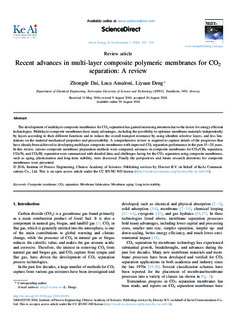| dc.contributor.author | Dai, Zhongde | |
| dc.contributor.author | Ansaloni, Luca | |
| dc.contributor.author | Deng, Liyuan | |
| dc.date.accessioned | 2019-01-21T09:16:39Z | |
| dc.date.available | 2019-01-21T09:16:39Z | |
| dc.date.created | 2016-09-16T09:36:23Z | |
| dc.date.issued | 2016 | |
| dc.identifier.citation | Green Energy & Environment. 2016, 1 (2), 102-128. | nb_NO |
| dc.identifier.issn | 2468-0257 | |
| dc.identifier.uri | http://hdl.handle.net/11250/2581405 | |
| dc.description.abstract | The development of multilayer composite membranes for CO2 separation has gained increasing attention due to the desire for energy efficient technologies. Multilayer composite membranes have many advantages, including the possibility to optimize membrane materials independently by layers according to their different functions and to reduce the overall transport resistance by using ultrathin selective layers, and less limitations on the material mechanical properties and processability. A comprehensive review is required to capture details of the progresses that have already been achieved in developing multilayer composite membranes with improved CO2 separation performance in the past 15–20 years. In this review, various composite membrane preparation methods were compared, advances in composite membranes for CO2/CH4 separation, CO2/N2 and CO2/H2 separation were summarized with detailed data, and challenges facing for the CO2 separation using composite membranes, such as aging, plasticization and long-term stability, were discussed. Finally the perspectives and future research directions for composite membranes were presented. | nb_NO |
| dc.language.iso | eng | nb_NO |
| dc.publisher | Elsevier | nb_NO |
| dc.rights | Attribution-NonCommercial-NoDerivatives 4.0 Internasjonal | * |
| dc.rights.uri | http://creativecommons.org/licenses/by-nc-nd/4.0/deed.no | * |
| dc.title | Recent advances in multi-layer composite polymeric membranes for CO2 separation: A review | nb_NO |
| dc.type | Journal article | nb_NO |
| dc.type | Peer reviewed | nb_NO |
| dc.description.version | publishedVersion | nb_NO |
| dc.source.pagenumber | 102-128 | nb_NO |
| dc.source.volume | 1 | nb_NO |
| dc.source.journal | Green Energy & Environment | nb_NO |
| dc.source.issue | 2 | nb_NO |
| dc.identifier.doi | 10.1016/j.gee.2016.08.001 | |
| dc.identifier.cristin | 1382013 | |
| dc.relation.project | EC/FP7/608555 | nb_NO |
| dc.relation.project | Norges forskningsråd: 215732 | nb_NO |
| dc.description.localcode | © 2016, Institute of Process Engineering, Chinese Academy of Sciences. Publishing services by Elsevier B.V. on behalf of KeAi Communications Co., Ltd. This is an open access article under the CC BY-NC-ND license (http://creativecommons.org/licenses/by-nc-nd/4.0/). | nb_NO |
| cristin.unitcode | 194,66,30,0 | |
| cristin.unitname | Institutt for kjemisk prosessteknologi | |
| cristin.ispublished | true | |
| cristin.fulltext | original | |
| cristin.qualitycode | 1 | |

